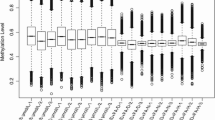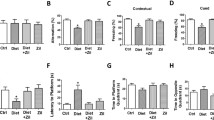Abstract
Purpose
Alzheimer’s disease (AD) is a highly prevalent type of dementia. The epigenetic mechanism of gene methylation provides a putative link between nutrition, one-carbon metabolism, and disease progression because folate deficiency may cause hypomethylation of promoter regions in AD-relevant genes. We hypothesized that folic acid supplementation may protect neuron cells from amyloid β (Aβ) oligomer-induced toxicity by modulating DNA methylation of APP and PS1 in AD models.
Methods
Primary hippocampal neuronal cells and hippocampal HT-22 cells were incubated for 24 h with a combination of folic acid and either Aβ oligomers or vehicle and were then incubated for 72 h with various concentrations of folic acid. AD transgenic mice were fed either folate-deficient or control diets and gavaged daily with various doses of folic acid (0 or 600 μg/kg). DNA methyltransferase (DNMT) activity, cell viability, methylation potential of cells, APP and PS1 expression, and the methylation of the respective promoters were determined.
Results
Aβ oligomers lowered DNMT activity, increased PS1 and APP expression, and decreased cell viability. Folic acid dose-dependently stimulated methylation potential and DNMT activity, altered PS1 and APP promoter methylation, decreased PS1 and APP expression, and partially preserved cell viability. Folic acid increased PS1 and APP promoter methylation in AD transgenic mice.
Conclusion
These results suggest a mechanism by which folic acid may prevent Aβ oligomer-induced neuronal toxicity.









Similar content being viewed by others
Abbreviations
- Aβ:
-
Amyloid β-peptide
- AD:
-
Alzheimer’s disease
- APP:
-
Amyloid precursor protein
- CBS:
-
Cystathionine-beta-synthase
- DMEM:
-
Dulbecco’s Modified Eagle’s Medium
- DNMT:
-
DNA methyltransferase
- FBS:
-
Fetal bovine serum
- OD:
-
Optical density
- PBS:
-
Phosphate-buffered saline
- PS:
-
Presenilin
- SAH:
-
S-adenosylhomocysteine
- SAM:
-
S-adenosylmethionine
References
Chan KY, Wang W, Wu JJ, Liu L, Theodoratou E, Car J, Middleton L, Russ TC, Deary IJ, Campbell H, Wang W, Rudan I, Global Health Epidemiology Reference Group (GHERG) (2013) Epidemiology of Alzheimer’s disease and other forms of dementia in China, 1990–2010: a systematic review and analysis. Lancet 381:2016–2023
Reitz C, Mayeux R (2014) Alzheimer disease: epidemiology, diagnostic criteria, risk factors and biomarkers. Biochem Pharmacol 88:640–651
Marshall KE, Marchante R, Xue WF, Serpell LC (2014) The relationship between amyloid structure and cytotoxicity. Prion 8:28860
Selkoe DJ (2008) Soluble oligomers of the amyloid beta-protein impair synaptic plasticity and behavior. Behav Brain Res 192:106–113
Hinterberger M, Fischer P (2013) Folate and Alzheimer: when time matters. J Neural Transm 120:211–224
Matsui T, Ingelsson M, Fukumoto H, Ramasamy K, Kowa H, Frosch MP, Irizarry MC, Hyman BT (2007) Expression of APP pathway mRNAs and proteins in Alzheimer’s disease. Brain Res 1161:116–123
Fuso A, Scarpa S (2011) One-carbon metabolism and Alzheimer’s disease: is it all a methylation matter? Neurobiol Aging 32:1192–1195
Zhuo JM, Wang H, Praticò D (2011) Is hyperhomocysteinemia an Alzheimer’s disease (AD) risk factor, an AD marker, or neither? Trends Pharmacol Sci 32:562–571
Scarpa S, Fuso A, D’Anselmi F, Cavallaro RA (2003) Presenilin 1 gene silencing by S-adenosylmethionine: a treatment for Alzheimer disease? FEBS Lett 541:145–148
Fuso A, Nicolia V, Ricceri L, Cavallaro RA, Isopi E, Mangia F, Fiorenza MT, Scarpa S (2012) S-adenosylmethionine reduces the progress of the Alzheimer-like features induced by B-vitamin deficiency in mice. Neurobiol Aging 33:1482.e1–1482.e16
Fuso A, Cavallaro RA, Nicolia V, Scarpa S (2012) PSEN1 promoter demethylation in hyperhomocysteinemic TgCRND8 mice is the culprit, not the consequence. Curr Alzheimer Res 9:527–535
Jiang Y, Sun T, Xiong J, Cao J, Li G, Wang S (2007) Hyperhomocysteinemia-mediated DNA hypomethylation and its potential epigenetic role in rats. Acta Biochim Biophys Sin (Shanghai) 39:657–667
Fuso A, Seminara L, Cavallaro RA, D’Anselmi F, Scarpa S (2005) S-adenosylmethionine/homocysteine cycle alterations modify DNA methylation status with consequent deregulation of PS1 and BACE and beta-amyloid production. Mol Cell Neurosci 28:195–204
Rushworth JV, Griffiths HH, Watt NT, Hooper NM (2013) Prion protein-mediated toxicity of amyloid-β oligomers requires lipid rafts and the transmembrane LRP1. J Biol Chem 288(13):8935–8951
Yideng J, Jianzhong Z, Ying H, Juan S, Jinge Z, Shenglan W, Xiaoqun H, Shuren W (2007) Homocysteine-mediated expression of SAHH, DNMTs, MBD2, and DNA hypomethylation potential pathogenic mechanism in VSMCs. DNA Cell Biol 26:603–611
Fuentealba RA, Liu Q, Zhang J, Kanekiyo T, Hu X, Lee JM, LaDu MJ, Bu G (2010) Low-density lipoprotein receptor-related protein 1 (LRP1) mediates neuronal Abeta42 uptake and lysosomal trafficking. PLoS ONE 5(7):e11884
Du H, Guo L, Yan S, Sosunov AA, McKhann GM, Yan SS (2010) Early deficits in synaptic mitochondria in an Alzheimer’s disease mouse model. Proc Natl Acad Sci USA 107(43):18670–18675
Huang G, Dragan M, Freeman D, Wilson JX (2005) Activation of catechol-O-methyltransferase in astrocytes stimulates homocysteine synthesis and export to neurons. Glia 51(1):47–55
Kim SH, Lu HF, Alano CC (2011) Neuronal Sirt3 protects against excitotoxic injury in mouse cortical neuron culture. PLoS ONE 6(3):e14731
Yu HL, Li L, Zhang XH, Xiang L, Zhang J, Feng JF, Xiao R (2009) Neuroprotective effects of genistein and folic acid on apoptosis of rat cultured cortical neurons induced by beta-amyloid 31–35. Br J Nutr 102(5):655–662
Li W, Yu M, Luo S, Liu H, Gao Y, Wilson JX, Huang G (2013) DNA methyltransferase mediates dose-dependent stimulation of neural stem cell proliferation by folate. J Nutr Biochem 24(7):1295–1301
Luo S, Zhang X, Yu M, Yan H, Liu H, Wilson JX, Huang G (2013) Folic acid acts through DNA methyltransferases to induce the differentiation of neural stem cells into neurons. Cell Biochem Biophys 66(3):559–566
Lee S, Lemere CA, Frost JL, Shea TB (2012) Dietary supplementation with S-adenosyl methionine delayed amyloid-β and tau pathology in 3xTg-AD mice. J Alzheimers Dis 28:423–431
Rogaev EI, Lukiw WJ, Lavrushina O, Rogaeva EA, St George-Hyslop PH (1994) The upstream promoter of the beta-amyloid precursor protein gene (APP) shows differential patterns of methylation in human brain. Genomics 22(2):340–347
Acknowledgments
The authors state that they have nothing to disclose, and that there are no potential conflicts of interest. This research was supported by grants from the National Natural Science Foundation of China (Nos. 81130053 and 81202200). The authors’ responsibilities were as follows—G. Huang: planned experiments; H. Liu, S. Zhao, X. Zhang: performed experiments; W. Li, M. Zhang, Y. Xiao: analyzed data; H. Liu, W. Li, J.X. Wilson: wrote the paper.
Author information
Authors and Affiliations
Corresponding author
Additional information
Huan Liu and Wen Li contributed equally to this work.
Rights and permissions
About this article
Cite this article
Liu, H., Li, W., Zhao, S. et al. Folic acid attenuates the effects of amyloid β oligomers on DNA methylation in neuronal cells. Eur J Nutr 55, 1849–1862 (2016). https://doi.org/10.1007/s00394-015-1002-2
Received:
Accepted:
Published:
Issue Date:
DOI: https://doi.org/10.1007/s00394-015-1002-2




